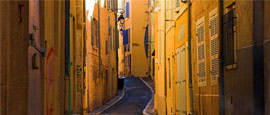La Corniche is a scenic road following the coastline from the Catalans to the enormous marble statue of David 3.5km (2 miles) further east. Keep an eye out for the Vallon des Auffes, a picturesque fishing village, before reaching the Prado beaches. The road continues to La Pointe Rouge, where more sands await.
Things to see in Marseille
Tourist offices
Address: 11 La Canebière, Marseille, France
Tel: +33 8 2650 0500.
Opening Hours:Mon-Sat 0900-1900, Sun 1000-1700. www.marseille-tourisme.com
The tourist office has a good selection of leaflets in English covering the major places of interest in Marseille and the surrounding areas, as well as maps. There is another, smaller office at the train station.
The Marseille City Pass includes free transportation (including a sightseeing train and boat trip to Chateau d'If), free entry to museums, free guided tours and discounts in selected shops. It is available for one to three days. Passes can be purchased from the tourist office or participating outlets.
Occupying Marseille’s highest point, 147m (482ft) above sea level, the neo-Byzantine basilica was built in the 19th century. Nicknamed Bonne Mère (good mother), it is topped by a gilded statue of the Virgin, who is said to bestow protection on fishermen. The mosaics are particularly beautiful, and there are magnificent views.
Overlooked by Fort St Nicholas and Fort St Jean, and thronged with masts, Vieux Port is the heart of Marseille. It’s a great place simply to stroll and soak up the atmosphere, especially among its many quayside restaurants. Marseille’s lively fish market takes place here daily on Quai des Belges.
This beautiful abbey was built in the 5th century on the burial place of Saint Victor, a Roman martyr. The abbey was destroyed several times over the years, until being fortified by Pope Urban V in the 14th century. The crypt is particularly atmospheric. The abbey regularly hosts concerts of religious music.
Built between 1947 and 1952 by famed architect Le Corbusier, the Cité Radieuse (literally ‘radiant city’) is a housing development in the southern suburbs of Marseille. For architecture buffs, it’s virtually unmissable – it was the first of Le Corbusier’s Unités d’Habitation and houses some 1,500 residents as well as a hotel, church and rooftop garden.
The maze of narrow streets found in the Quartier du Panier, the oldest part of Marseille, lead to the Vieille Charité, a pretty set of 17th-century buildings. Today the complex is an art centre, with two museums, several art galleries, a cinema, a café, a restaurant and a bookshop.
Built in 2013 to celebrate Marseille’s year as the European Capital of Culture, this audaciously designed gallery in the rejuvenated docks district puts on exhibits from all over the Mediterranean. Use the footbridge connecting it to Fort Saint Jean to explore the rooftop terrace before descending via the glassed-in external staircase.
This natural history museum does what it says on the tin - and in some detail too. There are permanent exhibits looking at the evolution of man and fossil specimens found in Provence, but the most eye-catching element of the attraction is the Safari Museum, which showcases some 300 mounted animals.
Situated halfway between Le Prado and the Corniche, Parc Borély is a tranquil expanse of greenery complete with a duck-filled lake and rowing boats for hire. There is also a botanical garden, a rose garden and even a chateau. Cycling is allowed in the park, with bicycles for hire at the entrance.
Football is sacred in Marseille, and an Olympique de Marseille home match is an exhilarating way of experiencing the local character in its most unbridled form. The stadium is also the setting for large-scale concerts and festivals. Next door is a museum for footie fans, with plenty of information on Les Phocéens.
Do you have any Feedback about this page?
© 2025 Columbus Travel Media Ltd. All rights reserved. No part of this site may be reproduced without our written permission, click here for information on Columbus Content Solutions.








 You know where
You know where